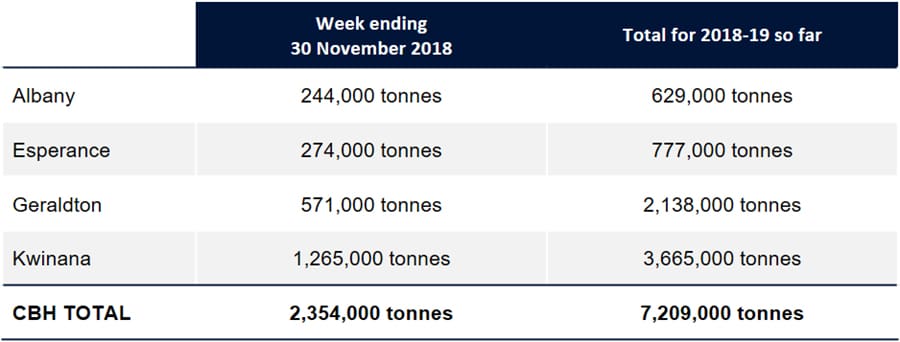WESTERN Australian growers have delivered 2.4 million tonnes (Mt) of grain in the week to 30 November into CBH Group storages to lift the state’s total to 7.2Mt, or close to half the expected tonnage, in the harvest to date, according to CBH Group’s latest harvest report.

Table 1: CBH recevials for the harvest to date, and for the week to 30 November. Image: CBH Group
CBH Group said shipping of new-crop grain has begun in most zones, and road and rail transport from country sites in Geraldton and Albany zone was now expected to increase.
“This week, the separation between our northern and southern zones this harvest has become more pronounced, with cool weather slowing progress in Albany and Esperance zones,” general manager operations David Capper said.
Receivals in all zones ramped up towards the end of last week.
“Given these delays, we expect to be busy over Christmas and into the New Year, with a late finish to harvest forecast.”
CBH Group said the barley market softened last week after the trade covered its short positions, and the market was now looking for fresh demand after interest from China dried up on the announcement of its investigation into Australia’s dumping of barley into its market.
Prices for feed barley eased by $6-8/t to $302-$304/t free in store (FIS), and malting values eased by the same amount to the mid $340s FIS.
Grower selling for feed was relatively active over the past week, as growers looked to offload some uncontracted tonnage.
CBH Group’s barley deliveries were close to 3Mt at the end of last week, or close to 70 per cent of the estimated intake for this harvest.
In the canola market, prices remained firm, with some grower selling, and buying interest from the European market.
CBH Group said Europe has continued to look for cover for January-shipment onwards, with earlier commitments already complete.
WA’s canola harvest was well advanced, with estimates at 70-75pc, and a large portion of this already sold.
Canola traded at around $570/t FIS throughout last week.
The wheat market jumped early last week as the trade looked for some grower liquidity.
A slow harvest has seen growers reluctant to contract additional tonnage before gauging how yields and harvest progress transpire.
By mid-week, increased grower selling resulted in the market easing $5-7/t to the mid $340s FIS.
As harvest progresses, protein is clearly down, and a larger proportion of ASW was now being seen, which has lifted values for higher-protein grades.
The wheat harvest is roughly 30pc complete, and well behind previous seasons.
Albany
Progress in this southwestern zone has continued to be slow due to wet weather, with only 244,000t received over the week to take the total to 629,000t.
This compared with this time last year, when 1.3Mt had been received.
Grain received to date has largely been barley, with some canola, and small loads of wheat have started to appear in the north of the zone.
“Even though we have had small tonnages received, quality continues to be good, with 45pc of barley making malt grades,” Albany zone manager Greg Thornton said.
“The impact of recent rain on wheat quality is unknown at this stage, but we will begin stack monitoring to gauge quality as wheat receivals increase in the coming week.
“Given the delayed start to harvest, we will be accumulating grain by both rail and road transport over the next few weeks from country receival points to meet shipping demands.”
“We will ensure that we minimise the impact to receivals of these activities, and with improved harvesting conditions over (this) week, we expect receivals to ramp up across the zone.”
Esperance
Harvest in the Esperance zone has continued to be slow, with around 38pc of its estimated receivals delivered to date.
These have comprised mostly barley and canola, with a small amount of wheat, and some lupins and field peas.
Poor weather last week once again slowed deliveries.
“I’m starting to sound like a broken record, but rain late last week slowed things up across the zone, with some isolated areas affected by hail during the same weather event,” Esperance zone manager Mick Daw said.
“Weather since the weekend has been mild and cool, which has continued to keep things damp.
“Hopefully we can get a week of good weather and start to get some reasonable tonnes delivered.”
Geraldton
With 571,000t delivered in the Geraldton zone in the week to 30 November, Geraldton had its busiest week of the current harvest to date.
The zone now has 2.2Mt of new-crop grain in the system, which makes up more than 85pc of expected receivals for the year.
Receivals have been mostly wheat, with smaller amounts of barley, canola and lupins.
Intake of some segregations has hit capacity at some sites and closed.
“We have started our heavy shipping, which has been a welcome relief, also allowing rail and road to start up at major receival points,” Geraldton zone manager Duncan Gray said.
“We are starting to see a small number of growers in the north start to finish their harvest program, but on the whole, I think it’s still going to be very busy for some time.”
Kwinana
Kwinana zone has also had its busiest week for the harvest to date, with almost 1.3Mt being delivered to bring this harvest’s total to close to 3.7Mt, nearly half its forecast intake.
“We have had many sites breaking their daily tonnage records…and, as more growers get on to wheat, I think we will see more records broken, as wheat yields are much better than we expected,” Kwinana assistant zone manager Allan Walker said.
Sites which broke daily receival records last week included: Beacon; Bodallin; Cadoux; Dowerin New; Koorda, Kondinin 2; Merredin; Narembeen; Watheroo, and Wyalkatchem.
Source: CBH Group

HAVE YOUR SAY